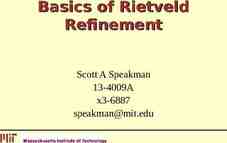Training for Chaplains and Therapists May 15, 10:30 am -6:30 pm,
60 Slides1.78 MB

Training for Chaplains and Therapists May 15, 10:30 am -6:30 pm, Eastern Time z Building Spiritual Strength

z J. Irene Harris, Ph.D., L.P. Your Trainers Timothy J. Usset, MDiv, MPH, LMFT, BCC Army Reserve Chaplain, 7 years Fellow, Transforming Chaplaincy project Most experienced BSS chaplain facilitator in the USA U. of Minnesota Research in psychology of religion for over 20 years, focus on trauma for 15 years. Over 30 publications in the peer-reviewed research literature

z Disclosure Presenters have no relevant financial or non-financial relationships to disclose relating to the content of this activity; or presenter(s) must disclose the type of affiliation/financial interest (e.g. employee, speaker, consultant, principal investigator, grant recipient) with company name(s) included. The views expressed in this presentation are those of the author and do not necessarily reflect the official policy or position of the Department of Defense, not the U.S. Government. This continuing education activity is managed and accredited by the Defense Health Agency J-7 Continuing Education Program Office (DHA J-7 CEPO). DHA J-7 CEPO and all accrediting organizations do not support or endorse any product or service mentioned in this activity. DHA J-7 CEPO staff, as well as activity planners and reviewers have no relevant financial or non-financial interest to disclose. Commercial support was not received for this activity.

z Disclaimer I am a VHA employee, and some of the research to be presented here is based on VHA funding, but the views expressed in this presentation are not necessarily those of VHA.

z Case Study: “Robert” Deployed 13 times over 10 years in Special Forces. Recently lost his military position due to posttraumatic stress disorder (PTSD) symptoms. Veteran underrepresented his suicide risk to enter study. Described losing all sense of purpose, felt that he was unable to do what God would want him to do; care for his military unit, forgive ex-wife, pursue meaningful helping career. Strong sense of self as “unforgivable.” This Photo by Unknown Author is licensed under CC BY-SA-NC

z Robert, p. 2 Session 2: Robert developed a new sense of a relationship with G-d as one that loves him intensely, and does not require him to be perfect to do so. Session 6: Robert discriminates forgiveness from reconciliation, and finds new ways to set boundaries in relationship with his exwife.

z Robert, p. 3 Robert now works as a licensed mental health provider, in a thriving private practice that focusses primarily on veterans managing PTSD.

Target Conditions: z Posttraumatic Stress Disorder Moral Injury/Spiritual Distress

Learning Objectives At the end of the activity, participants will be able to: 1. Describe basic symptoms and types of PTSD. z 2. Define the symptoms of moral injury. 3. Discriminate internalizing vs. externalizing presentations of moral injury. 4. Describe relationships between spiritual distress and trauma outcomes.

z Posttraumatic Stress Disorder (PTSD) A: Exposure to Trauma B. Intrusion Symptoms D. Negative Thoughts and Feelings C. Persistent Avoidance* E. Arousal/Reactivity

z Type I and Type II Trauma Combat Trauma Subtypes of PTSD Childhood Trauma Sexual Trauma Military Sexual Trauma/Sexual Assault/Sexual Harassment

z Moral Injury/Spiritual Distress The psychological and behavioral sequellae of experiences that challenge deeply held moral, spiritual, or values related beliefs. The value of using alternative terms for moral injury.

Signs of Moral Injury z Loss of previously held spiritual beliefs Struggle or conflict in relationship with a Higher Power Difficulty forgiving self, others, or a Higher Power Feeling that there is no meaning or purpose in life Reduced trust in others Inappropriate guilt and shame

Examples of z Moral Injury He said he would only fill my requisition for gun turret shields if I slept with him. People in my unit will die without those. The crowd threw an infant in front of the convoy to stop us. I had orders not to stop. My c.o. could have kept this from becoming a firefight, but he didn’t and 3 of my best friends died. I know whatever team I assigned to that position for this battle was likely to die. They were all calling “Medic!” but I could not get to all of them. I had to let some of them die. This Photo by Unknown Author is licensed under CC BY

z Circumstances that Can Precipitate Moral Injury Doing something that violates one’s own moral code Witnessing something that violates one’s moral code, cherished values, or spiritual assumptions. Feeling helpless to address a harmful situation Betrayal by authorities or peers

Living in Multiple Moral Contexts z Civilian morals, values, expectations This Photo by Unknown Author is licensed under CC BY-SA Rules of engagement This Photo by Unknown Author is licensed under CC BY

z Consequences of Moral Injury Increased risk for suicidal ideation and attempts Reduced mental health resilience Loss of social support from community of faith, family and values-based activities

z Alternative Treatments for Moral Injury

z Moral Injury and Psychospiritual Development Harris, J. I., Park, C. L., Currier, J. M., Usset, T. J., & Voecks, C. D. (2015). Moral injury and psycho-spiritual development: Considering the developmental context. Spirituality in Clinical Practice, 2(4), 256.

Developmental z Expectations Stage 4 is NOT related to being theological liberal or conservative; it is an internally responsible process for spiritual reasoning People are generally deployed ages 1825 Most at those ages are functioning at Fowler 2 or 3 Processing multiple moral contexts requires at least an approach to Fowler stage 4. Our choices are to either grow or collapse

z Dimensions of Moral Injury Exposure vs. Developmental Etiologic Models Internalizing vs. Externalizing Presentations Realistic Guilt vs. Sense of Guilt Categorical vs. continuous conceptualization of moral dilemmas Judging one’s young adult moral decision-making by older adult developmental standards Discriminate from antisocial functioning via temporal associations with exposure to moral injury A high percentage of those presenting in our lab are using sense of guilt as a terror management strategy; “If it was my fault, I had control of the situation.”

Assessing Psychospiritual z Development Fowler Religious Attitudes Scale Concerns about accurate results for apostates

z Clinical Assessment of Psychospiritual Development Conventional Faithful Conventional Apostate Postconventional Faithful Postconventional Apostate

Why Use Building Spiritual Strength or Spiritually Integrated Care? z z

z Making PTSD Treatment Accessible While highly effective, evidence-based treatments for 1,2 PTSD are accessed by only 11% of combat veterans, and 3-5 of those, almost half drop out of treatment . Building Spiritual Strength is a spiritually-integrated model for treating PTSD designed to reach veterans who will not access conventional mental health services. Dropout rates for BSS range from 6% to 14%

z Addressing Spiritual Components of PTSD Interventions targeting spiritual distress have effects on PTSD symptoms. Those who lose faith in the context of trauma have more psychopathology and use more mental health services, even 30 years later. Increasing research links spiritual distress to PTSD symptoms Longer, more severe course of PTSD Suicide risk in veterans managing PTSD

z Previous Pilot Study 56 Veterans with PTSD randomize d to BSS or a wait-list control group. Improved PTSD symptoms, depression symptoms, and positive religious coping as compared to the wait list. 9 Data trend suggests BSS is more effective for minority veterans.

z Second Study COMPARE BUILDING SPIRITUAL STRENGTH (BSS) TO AN ACTIVE CONTROL CONDITION (PRESENT CENTERED GROUP THERAPY: PCGT) FOR TREATING PTSD ASSESS EFFECTS OF BSS ON MORAL INJURY/SPIRITUAL DISTRESS EXAMINE BSS WHEN APPLIED BY CHAPLAINS WITH MENTAL HEALTH TRAINING AS THERAPISTS

z Study Design Randomized Clinical Trial comparing BSS to Present Centered Group Therapy (PCGT) Treatment nested within therapists Manualized in both conditions with fidelity monitoring Clinician Administered PTSD Scale (CAPS) (Pre and Post) and PTSD Checklist (PCL) (Pre, Post, Follow-up) for PTSD Religious and Spiritual Struggles Scale (RSSS) for moral injury/spiritual distress 71 randomized to BSS, 67 randomized to PCGT

Participant z s Average age 58.33 (SD 13.00) 14% female 70% Caucasian, 8% AfricanAmerican, 3% Hispanic, 1% each Asian, Native American, Multiracial, 17% Unreported 38 Catholic, 84 Protestant, 5 Agnostic, 13 Spiritual but not Religious, 1 Sufi, 2 Jewish, 1 Native American Spiritualty, 1 Shinto (note that some participants reported multiple faith affiliations) Harris, J. I., Usset, T., Voecks, C., Thuras, P., Currier, J., & Erbes, C. (2018). Spiritually integrated care for PTSD: A randomized controlled trial of “Building Spiritual Strength”. Psychiatry research, 267, 420-428.

z Study Results-PTSD Symptoms Clinician Administered PTSD Scale (CAPS) PTSD Checklist (PCL) F[1,78] 1.44, p .23, η2 .02 t (condition) 1.62, p .107 t (time x condition) -0.873, p .384 Harris, J. I., Usset, T., Voecks, C., Thuras, P., Currier, J., & Erbes, C. (2018). Spiritually integrated care for PTSD: A randomized controlled trial of “Building Spiritual Strength”. Psychiatry research, 267, 420-428.

z Study Results-Spiritual Distress Harris, J. I., Usset, T., Voecks, C., Thuras, P., Currier, J., & Erbes, C. (2018). Spiritually integrated care for PTSD: A randomized controlled trial of “Building Spiritual Strength”. Psychiatry research, 267, 420-428. Divine Doubt Ultimate Meaning t (time x condition) -3.24, p .001 t (time x condition) -0.30, p .764 t (time x condition) 0.23, p .821 Moral Interpersonal Demonic t (time x condition) -1.10, p .276 t (time x condition) -0.22, p .830 t (time x condition) -0.95, p .346

z Attributes of Divine Distress Scale Psychometrically strongest subscale of the RSSS Eigenvalue 10.0 (next largest on scale is 3.0) 38% of the variance measured by the scale α .93 Items Felt as though G-d had let me down Felt angry at G-d Felt as though G-d had abandoned me Felt as though G-d was punishing me Questioned G-d’s love for me

z Correlates of Divine Distress Scale Depression (r .42, p .01) Anxiety (r .40, p .01) Anger (r .34, p .01) Loneliness (r .35, p .01) Presence of Meaning in Life (r -.22, p .01) Life Satisfaction (r -.21, p .01)

z Previous Research in Divine Distress Killing Divine Distress Killing -Divine Distress -Killing Divine Distress -Killing -Divine Distress

z Conclusions No statistically significant differences between BSS and an active control condition (PCGT) in treating PTSD symptoms BSS is more effective than PCGT in treating spiritual distress. To our knowledge, this is the only clinical trial of a treatment for moral injury/spiritual distress that documents reduction of spiritual distress. Further study of psychospiritual development is indicated.

PART II z Techniques AND Foundations

z Theory and Foundations for BSS https://www.youtube.com/ watch? v AEnAe5cn6yA&list PLnh2 PvQFlZsnaxU0sPA8W24OsHxdgqFo&index 2&t 0s

z Learning Objectives Be Describe Summarize Summarize Identify At the end of the activity, the participants will be able to : Describe the Building Spiritual Strength Intervention. Summarize the outcome research on BSS. Summarize the rationale for using BSS. Identify the types of spiritual distress that are most associated with trauma outcomes.

z Building Spiritual Strength Intervention Session 1: Orientation to group rules, limits of confidentiality, “storytelling;” establishing rapport Sessions 2-3: Developing skills and tools for communication with a Higher Power Session 4: Theodicy Session 5: Meditative and prayer coping Sessions 6-7: Forgiveness Session 8: Consolidation of gains, identification of future resources.

z Voluntary consent to spiritually integrated care Ethics Concerns Inclusive and Personalized language Special concerns in public health settings Proselytizing; educate group members Spirituality/individual differences/culture in providers’ ethics codes Joint Commission requirements for spiritually integrated care

z Chaplain s Nature of Higher Power Scripture Consistency of beliefs with stated affiliation Use of self-disclosure Licensed Mental Health Provider s Impact of anxiety/depression on perceptions of relationships This includes the relationship with a Higher Power Education about PTSD/depression/psychopathology Different ideas about self-disclosure than we see in chaplaincy culture Scope of Practice

z Intake: Appropriateness for Group Intervention Review intake Interview Safety (self and others) Ability to remain socially appropriate/respond to redirection Substance Use Practice session with interview schedule provided.

If Safety Concerns z Emerge What is your plan? Do you have the materials you need to enact the plan? When do you plan to do this? Are there reasons you would not do this? DO Connect with appropriate services instead of BSS (Consult with local mental health leadership before meeting with clients to identify specific services.) DON’T Manage threat of harm to self or others alone Promise to keep a secret (know mandatory reporting laws in your state)

z Critical Counseling SkillsIndividual Unconditional positive regard Think about this in a client with externalizing moral injury Reflective listening Open ended questions VALIDATION Reframing Paradoxical intervention

z Critical Counseling Skills-Group Establishing group norms Modeling behaviors, especially in empty chair exercises Joining Helping group members share time appropriately Address monopolizing Address silence Keeping group constructive Address off-task, avoidant, unconstructive Address help-rejecting complaint patterns And of course, do it all nonjudgmentally!

z Logistics Staffing Space Snacks/beverages if possible Materials Workbooks “Good Goats” Pencils Recruiting Group Size

z Ground Rules (p 12) This is an interfaith environment. Many different approaches to faith will be represented. We will respect each others’ beliefs, experiences, and feelings; we do not have to agree with a belief to respect it. Members and leaders all are empowered to address difficulties in respecting each other. No one will be asked to accept any doctrine that is inconsistent with their faith. All of us have endured difficult experiences. If we have chosen to be in this group, we are likely seeking to make some changes in our relationship with Higher Power. All of us have the right to change our mind about our beliefs. And change it again, or change it back. Our relationship with Higher Power is likely to change as we grow just as our relationships with people change as we grow. Material we discuss in group is confidential. Our peers in group should not share information about others in group outside of this setting. It is OK to share what you personally are experiencing in group in any environment you feel is safe for you. Activities will be presented to facilitate your faith development. If you do not want to participate in an activity, that is your choice. Leaders will ask about your feelings and barriers to your participation to help you get the most out of group, but you do not have to do anything you do not want to do. If you cannot be at a group session, please let a leader know in advance.

z Learning Objectives At the end of the activity, the participants will be able to: 1. Review the theoretical basis for Building Spiritual Strength. 2. Identify the goals for each of the 8 sessions in the BSS protocol. 3. Identify relevant ethics considerations for both BSS and spiritually integrated 4. 5. 6. 7. 8. care. Practice basic interviewing and counseling skills. Identify the practical/logistical requirements for a BSS program. Identify the goals for each of the 8 sessions in the BSS protocol. Describe techniques for establishing ground rules and behavioral norms for BSS groups. Practice the “Empty Chair” technique.

z Session 1 (Page 14) Greetings/Introductions Workbooks (Higher Power or Traditional Version) Plan group formats Review of last week Discuss homework New material Group decisions; Opening/closing ritual? Breaks? Prayer/Silent Meditation? Rapport Development Activities Encourage veterans to find common experiences Goal Setting

z Sessions 2-3 (page 17) Review Homework Rituals as determined by group Empty Chair Exercise https://www.youtube.com/playlist?list PLnh2PvQFlZsnaxU0sPA-8W24O sHxdgqFo This session is critical; most progress in group comes from this session or technique.

z Sessions 2-3 Continued (Page 19) 2- Way Prayer/Meditation Log One concern at a time If Higher Power’s response is painful, bring to group If “stuck” or “radio silence” from Higher Power, bring to group Use log entries as springboard to repeat empty chair exercise as often as possible.

z Session 4: Theodicy (page 26) Ritual as determined by group Check in with logs Empty chair exercise as indicated You need reserve only 30-40 minutes for theodicy material; focus more on logs Explore personal theodicies, theodicies in workbook Red-flag theodicies G-d is punishing me or others G-d is showing power Abandoning a G-d that is inconsistent with Fowler 2 or 3 G-d concepts

z Session 5: Communication/Meditative and Prayer Coping (page 29) Ritual as determined by group Check in with logs Empty chair exercise as indicated You need reserve only 30-40 minutes for instructional material; focus more on logs Work through questions on prayer/meditation practice and skill development

z Session 5, con’t Teach about prayer/meditative coping strategies Seeking Calm and Focus Seeking Assistance Seeking Acceptance Setting it Aside (deferring)

z Sessions 6 & 7 Ritual as determined by group Check in with logs Empty chair exercise as indicated Basic Themes for Instruction (page 32) Forgiveness is voluntary Pretending it did not happen is not forgiveness Reconciliation is not the same as forgiveness Forgiveness is a process, not an event https://www.youtube.com/playlist?list PLnh2PvQFlZsnaxU0sPA-8W24OsHxdgqFo

z Session 8 (page 40) Ritual as determined by group Process goals Consolidate gains Share feelings about relationships in group Develop local resource lists for further support.

z Key Takeaway s Chaplains and mental health providers have unique contributions to make in treatment of moral injury. Existing research indicates that Building Spiritual Strength is an intervention that can help individuals managing moral injury. Seek appropriate supervision/consultation when implementing a new intervention.

z References Bryan, A. O., Bryan, C. J., Morrow, C. E., Etienne, N., & Ray-Sannerud, B. (2014). Moral injury, suicidal ideation, and suicide attempts in a military sample. Traumatology, 20(3), 154. Exline, J. J., Pargament, K. I., Grubbs, J. B., & Yali, A. M. (2014). The Religious and Spiritual Struggles Scale: Development and initial validation. Psychology of Religion and Spirituality, 6(3), 208. Litz, B. T., Stein, N., Delaney, E., Lebowitz, L., Nash, W. P., Silva, C., & Maguen, S. (2009). Moral injury and moral repair in war veterans: A preliminary model and intervention strategy. Clinical psychology review, 29(8), 695-706. Harris, J. I., Park, C. L., Currier, J. M., Usset, T. J., & Voecks, C. D. (2015). Moral injury and psycho-spiritual development: Considering the developmental context. Spirituality in Clinical Practice, 2(4), 256. Harris, J. I., Usset, T., Voecks, C., Thuras, P., Currier, J., & Erbes, C. (2018). Spiritually integrated care for PTSD: A randomized controlled trial of “Building Spiritual Strength”. Psychiatry research, 267, 420-428. Park, C. L., Currier, J. M., Harris, J. I., & Slattery, J. M. (2017). Trauma, meaning, and spirituality: Translating research into clinical practice. Washington, D.C: American Psychological Association.

z Questions/Discussion? https://marketplace.va.gov/practices/building-spiritu al-strength [email protected] 781-687-4316






